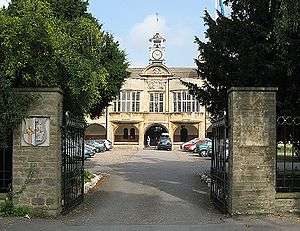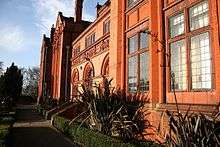Lincoln Christ's Hospital School
 | |
| Established | 1974 |
|---|---|
| Type | Academy |
| Religion | Christian |
| Headteacher | Martin Mckeown |
| Location |
Wragby Road Lincoln Lincolnshire LN2 4PN England Coordinates: 53°14′21″N 0°31′21″W / 53.2391°N 0.5225°W |
| DfE number | 925/5408 |
| DfE URN | 137447 Tables |
| Ofsted | Reports |
| Students | 1380 |
| Gender | Coeducational |
| Ages | 11–18 |
| Houses | Bluecoats, Minster, Lindum, Greyfriars |
| Colours | Blue, yellow, green, red |
| Former name | Lincoln School, |
| Website | Official website |
Lincoln Christ's Hospital School is a state secondary school with academy status located on Wragby Road in Lincoln, Lincolnshire, England.
The school was established in 1974, taking over the pupils and many of the staff of the ancient Lincoln Grammar School, Christ's Hospital Girls' High School (established in 1893), and two 20th-century secondary modern schools, St Giles's and Myle Cross.


History
Hospital schools date from the 13th century as boys' schools for parents who could not afford to pay school fees. They were also known as charity schools. The former Lincoln School may have dated from the 11th century, but it was re-founded as a charity school in the 17th century.
The endowment for Christ's Hospital Girls' School was derived from the former Bluecoat School on Christ's Hospital Terrace, Lincoln which was closed in 1883. This school was originally established in 1614 in St. Mary's Guildhall, Lincoln before it was moved to Christ Hospital Terrace in 1623.[1]
The Garton Archive, established by Professor Garton, an Old Lincolnian, houses documents, records, photographs, and books detailing the history of the earlier schools.
Grammar schools
LCHS was formed from the merger of two single-sex grammar schools, both of which had some boarders (pupils who lived at the school during term-time). From 1906 the boys' school, Lincoln School (probably dating back to 1090),[2] also known as Lincoln Grammar School, occupied a site on Wragby Road. The girls' school, Christ's Hospital Girls' High School, was founded in 1893 and was based at Greestone Place on Lindum Hill. Before 1944, children whose education was not funded by the foundation had to pay school fees.
Lincoln School had many of the traditions of a public school. In 1914, after the beginning of the First World War, the school's buildings were commandeered for use as a hospital. Lincoln Cathedral choristers were educated at the school until 1944, when the school became a school maintained by public funds. In 1961 a new independent preparatory school for choristers, the Cathedral School for Boys, was established in the cathedral's former Deanery,[3] and was renamed as Lincoln Minster School in 1996; it has since replaced the role that Lincoln School held before 1944.
On 22 July 1941 an RAF Handley Page Hampden crashed into the boarding house of the Girls' High School on Greestone Stairs,[4][5] killing Miss Edith Catherine Fowle, a languages teacher, as well as the occupants of the aircraft. She had taught at the school for 21 years. By the 1960s the girls' school, a voluntary aided school, had around 550 girls, including 30 boarders.
Comprehensive
In September 1974 the City of Lincoln was the only part of the county in which Lincolnshire County Council decided to abolish selective education. As a result, the city's two grammar schools merged with two secondary modern schools founded in 1933, St Giles's Secondary Modern School for Boys on Swift Gardens and Myle Cross Secondary Modern School for Girls on Addison Drive, to become a new comprehensive school. The buildings of St Giles's are now a temporary primary school, and those of Myle Cross are the Chad Varah primary school.
After the merger of 1974, school uniform policy was relaxed. However, in 2007 school blazers and ties were reintroduced.
The present-day school has had Language College status since 2001, and offers lessons in French, Spanish, German, Mandarin Chinese, Russian and most recently Latin.[6]
Academy
Lincoln Christ's Hospital School became an academy in September 2011. It is now independent of local authority control, and funded directly from central government. However, the school continues to coordinate its admissions with Lincolnshire County Council.
Headmasters of Lincoln School
- 1911–1929: Reginald Moxon
- 1929–1937: Charles Edgar Young
- 1937–1957: George Franklin
- 1958–1962: Patrick Martin (later headmaster of Warwick School, 1962–77)
- 1962–1973: John Collins Faull
- 1973–1974: Arthur Behenna
Heads of Lincoln Christ's Hospital School
- 1974–1985: Arthur Behenna
- 1985–2004: David Cox
- 2005–2014: Andy Wright
- 2014–present: Martin Mckeown
Curriculum
Academic subjects studied include: English, Maths, Double and Triple Award Sciences, BTEC Science, Forensic and Medical Sciences*, Media, Modern Languages, Latin, History, Geography, RE, Psychology*, Sociology*, Philosophy and Ethics*, and Citizenship.
Vocational subjects studied include Fine Art, Art Textiles, BTEC Art, Music, Design & Technology, Drama, Drama & Theatre Studies*, Law*, ICT & Business Studies, Resistant Materials, Child Care, Electronics, Product Design*, Production Arts BTEC*, Performance Arts BTE*, Graphic Design, Photography, and Engineering*.
(*) 6th form only subject.
Academic performance
When a grammar school, LCHS would have been the best performing school in Lincoln. As a comprehensive, its results place it in the top five most improved language colleges nationally. It gets GCSE results slightly above average, but A level results below average.
Admissions
Pupil population is just under 1400, including over 300 in the sixth form. Of the school roll, 15% receive free school meals.
Notable former pupils
- Allison Pearson (born 1960), novelist and newspaper columnist
- Mike Cattermole (born 1961), TV horse racing correspondent : c.1978-79
- Marlon Beresford (born 1969), professional footballer with Middlesbrough F.C., Burnley F.C. and Luton Town F.C.: 1982–86
- Paul Palmer, Olympic silver medal-winning swimmer at Atlanta: c. 1986
- Emma Hurd, Sky News
- Pete Gold, voice-over artist for TV adverts and (mostly) BBC Radio 5 Live: c.1983-84 (then moved to Sheffield)
- Hannah McGill, film critic: c. 1990-94
Lincoln Grammar School
- Colonel John Hutchinson (1615–1664) Parliamentarian leader
- Sir Francis Thornhagh (1617–1648), Parliamentarian soldier and MP: c. 1628–33
- John Disney (1677–1730), churchman, and great-grandfather of John Disney the archaeologist: c. 1689–94
- Peniston Booth, priest : c.1692-99
- Thomas Pownall, Governor of Massachusetts in 1757–60: c. 1733–38
- John Sibthorp, botanist: c. 1770–75
- Henry Digby Beste, Christian scholar: 1776–84
- Richard Watson, Methodist minister: c. 1792–97
- John Taylor (English publisher): c.1792-1794
- Henry Whitehead Moss, scholar: c.1852-54
- Evelyn Abbott, Greek scholar: c. 1854–59
- George Francis Carline (1855–1920), RBA artist: 1866–73
- William Henry Battle, surgeon, known for Battle's sign : c. 1866–70
- James Ward Usher (1845–1921), art jeweller and philanthropist
- William Logsdail, artist: c. 1870–75
- Robert Humphreys OBE, director of Institute of Latin American Studies, 1965–74, and President of the Royal Historical Society, 1964–68: 1908–15
- Basil Boothroyd, humorous writer with Punch : c. 1921–26
- Alex Henshaw, Spitfire chief test pilot: 1922–27
- Flt Lt Edward Johnson DFC, bomb aimer of AJ-N Lancaster of the Dambuster 617 Sqn squadron, who destroyed the Eder Dam: 1923–30
- Noel Duckworth, coxed the 1934-36 Cambridge crews to victory in the Boat Race, and the 1936 Berlin Olympics GB Eight : 1924-31
- David Cartwright, Bishop of Southampton, 1984–89: 1931–38
- Steve Race (1921–2009), Home Service/Radio 4 presenter of My Music: 1932–39
- (Henry) St John Armitage CBE, Saudi Arabia diplomat: -1942[7]
- Sir Neville Marriner CH CBE, conductor: 1935–42
- Dennis Townhill OBE, organist: 1936–43
- Prof Charles Garton, Professor of Classics at the State University of New York at Buffalo: 1937-44[8]
- Keith Fordyce, Light Programme/Radio 2 disc jockey and first presenter of Ready Steady Go!: 1940–47
- David Robinson, arts journalist for The Times: 1941–48
- Michael Marshall (born 1936), Bishop of Woolwich 1975–84: 1947–54
- Colin Semper (born 1938), head of Religious Programmes 1966–69 at BBC Radio: 1949–57
- Sir David Blatherwick OBE (born 1941), UK Ambassador to Ireland and Egypt: 1952–59
- John Hurt (born 1940), actor: 1953–57
- Keith Graves, 1980s BBC News and Sky News foreign correspondent (started at the Lincolnshire Echo): 1952–57
- Derek Fatchett (1945–1999), Labour MP 1983–99 for Leeds Central: 1956–63
- Peter Day (born 1947), Home Service/Radio 4 presenter of In Business: 1958–65
- Bernard Theobald, former Leader of West Lindsey District Council, and former manager of Barbara Dickson: 1962–69
- Prof Chris Thompson FRCP, FRCPsych, Professor of Psychiatry from 1988-2003 at the University of Southampton, and Head of the School of Medicine from 2000-03, Chief Medical Officer from 2004-14 of the Priory Group: 1963–65
- Paul Hodgkinson CBE, Chairman and Chief Executive of Simons Group since 1986: 1967–74
- Mark Byford (born 1958), BBC deputy director-general: 1969–76
- Philip Braund, former Daily Mirror journalist, and ITV investigative documentary producer, Head of News at ITV from 2010-11: c. 1963–70
Christ's Hospital Girls' High School
- Jane Bennett-Powell, 1990s Channel 4 newsreader, daughter of John Bennett-Powell who worked with Sir Frank Whittle at Power Jets
- Bridget Cracroft-Eley (née Clifton-Brown), Lord Lieutenant of Lincolnshire 1995–2008: 1940s
- Nancy Durrell (née Myers), first wife of Lawrence Durrell, and mother of Joanna Hines, the author and Guardian crime fiction reviewer
- Mary Mackie (née Whitlam), novelist and non-fiction writer: 1953–58[9]
References
- ↑ Stocker, D. A., et al (1991).St Mary's Guildhall, Lincoln. The Survey and Excavation of a Medieval Building Complex C.B.A. /City of Lincoln Archaeology Unit:The Archaeology of Lincoln, Vol XII-1, p. 8.
- ↑ "A Brief History of Lincoln Christ's Hospital School", Christs-hospital.lincs.sch.uk. Retrieved 15 January 2012
- ↑ "The Deanery", Geograph.org.uk. Retrieved 15 January 2012
- ↑ "Greestone Stairs", Thebettahalf.co.uk. Retrieved 15 January 2012
- ↑ Benson, John, "Memories of Air Crashes in Lincolnshire", BBC Home - WW2 People's War. Retrieved 15 January 2012
- ↑ Languages
- ↑ St John Armitage
- ↑ Charles Garton
- ↑ "'Writer in Bud' by Mary Mackie (née Whitlam)", Lincoln Christ's Hospital School website. Retrieved 19 November 2013
